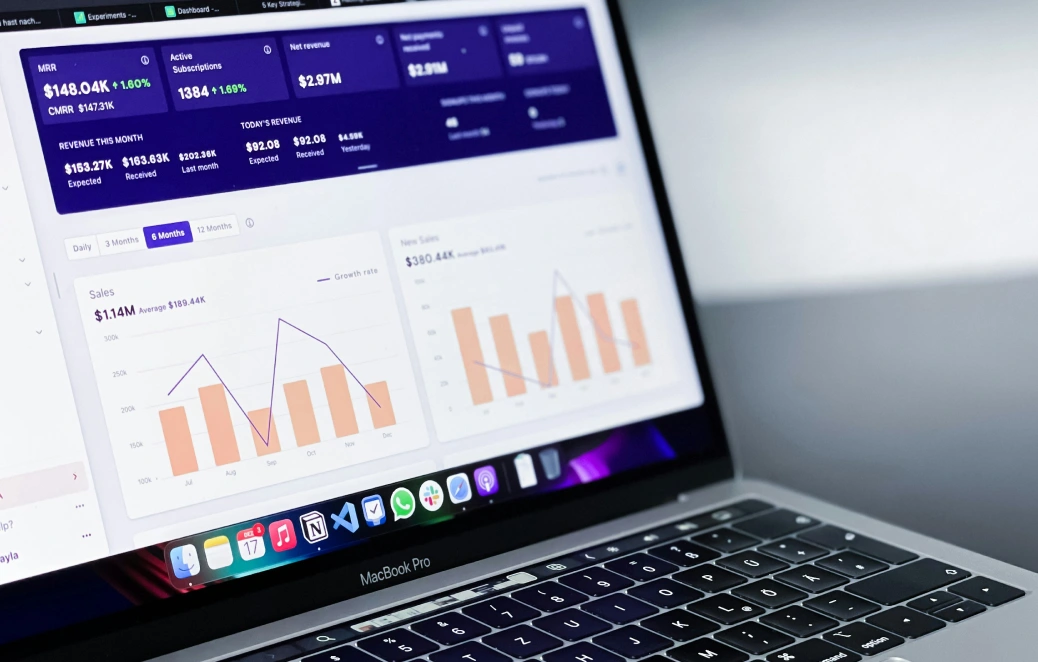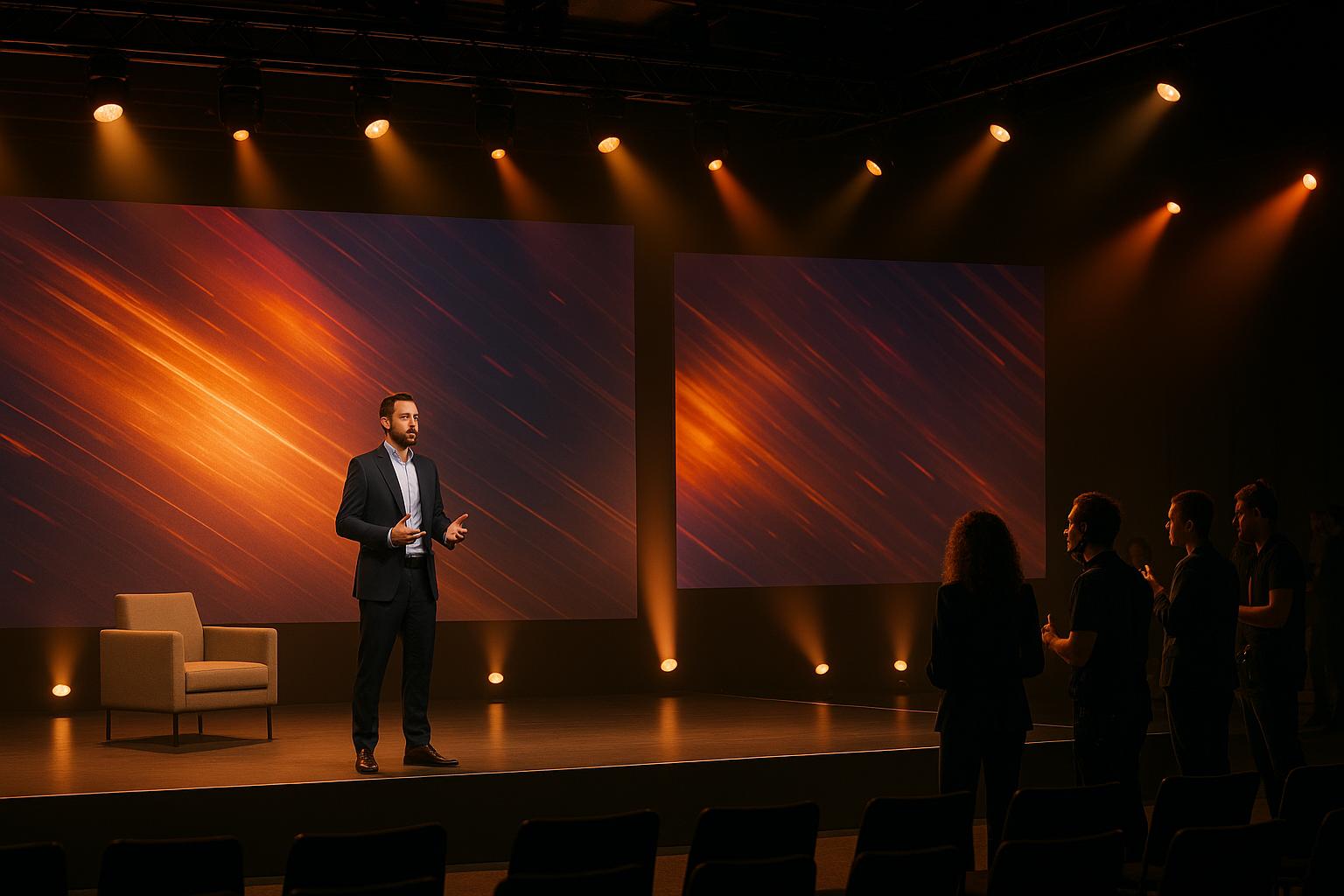Use This Successful Plan To Produce A Global Business Broadcast

Chief Executive Officer

Global business broadcasts are powerful tools for connecting organizations with audiences worldwide. These events go beyond simple video calls, incorporating professional audiovisual setups, real-time translations, and interactive elements to engage viewers across different countries. Whether it's announcing earnings, launching products, or training employees, a well-planned broadcast ensures consistent messaging and high engagement.
Here's what you need to know to plan and execute a successful global broadcast:
- Pre-Production: Develop a clear agenda, prepare speakers with detailed briefs and rehearsals, and coordinate time zones for maximum attendance. Budget carefully and plan for risks like connectivity issues or equipment failures.
- Audiovisual Setup: Use high-quality cameras, lighting, and microphones to ensure professional audio and video. Choose a reliable streaming platform, ensure sufficient bandwidth, and implement redundancy systems to avoid disruptions.
- Team Coordination: Manage cross-regional teams with cloud-based tools, clear communication protocols, and real-time updates. Address language and regional differences to enhance collaboration.
- Post-Event Analysis: Measure success with metrics like watch time, completion rates, and audience interaction. Use these insights to improve future broadcasts.
Vizrt at ISE 2025 – The Future of AV & Broadcast Production is Here!
Pre-Production Planning for a Global Broadcast
Planning a global broadcast requires careful attention to both content and technical logistics. Once the basic logistics are in place, the next steps involve fine-tuning the agenda and ensuring speakers are well-prepared.
Agenda Development and Speaker Preparation
When crafting the agenda for a global audience, it's important to strike a balance between delivering meaningful content and respecting varying attention spans. Break your core message into short, impactful segments, and make adjustments to suit different cultural expectations. Adding interactive features like live polls or Q&A can keep viewers engaged and involved.
For speakers, preparation is key. They need to connect with audiences they may never meet face-to-face. Provide them with detailed briefs that include cultural insights, pronunciation tips, and clear guidelines for appearing on camera. Rehearsals are essential - schedule enough time to help speakers feel confident and familiar with the format.
Use examples and case studies that resonate with a global audience. Interactive features like live polls, Q&A sessions, or breakout discussions can further enhance engagement. Assign dedicated team members to monitor and manage participation across various time zones to ensure smooth communication.
Time Zone Coordination and Scheduling
Scheduling a global broadcast requires thoughtful planning to maximize attendance while accommodating the diverse schedules of your audience. Start by identifying your key audience regions and their local business hours. Then, select time slots that align with peak viewing times in those areas.
Create a time zone chart that clearly outlines broadcast times for major regions, and distribute it widely. Don’t forget to factor in daylight saving time changes, as these can impact scheduling in different parts of the world.
If one session can’t cover everyone, consider hosting multiple broadcasts or involving regional moderators to cater to different time zones.
Budgeting and Risk Management
The cost of a global broadcast depends on factors like production complexity, duration, and audience size. To budget effectively, identify the major cost drivers and focus spending on areas that will deliver the most impact.
Once your schedule is finalized, align your budget to meet the technical and operational demands. Invest in a reliable technology infrastructure, including streaming services, sufficient bandwidth, and backup systems. Ensure funds are allocated for 24/7 technical support and include a financial buffer for unexpected expenses.
Prepare for potential challenges with contingency plans for issues like connectivity problems, speaker no-shows, platform outages, or equipment failures. Assign clear roles and establish communication protocols to handle these situations efficiently.
If working with international vendors, protect your budget from currency fluctuations by locking in exchange rates or setting aside additional funds. Lastly, explore insurance options tailored for global broadcasts, as standard event insurance may not cover technical issues that disrupt international viewership.
Audiovisual Technology and Broadcast Production
Once you've nailed down your pre-production logistics, the next step is ensuring your audiovisual setup is rock-solid. This technical foundation is what guarantees your broadcast reaches viewers without any hiccups in sound or visuals.
Choosing the Right AV Solutions
Camera selection: Invest in cameras capable of delivering consistent 1080p or 4K resolution with dependable auto-focus. A multi-camera setup is ideal - use one camera for wide shots of the stage, another for close-ups of speakers, and a third to capture audience reactions or product demonstrations.
Professional lighting: LED panel systems are your go-to for adjustable color temperatures ranging from 3,200K to 5,600K. Position key lights at a 45-degree angle to minimize shadows and balance the setup with fill lights for even illumination.
Audio quality: Crystal-clear sound is non-negotiable. Wireless lavalier microphones are great for speakers who move around, while handheld mics work well for Q&A sessions. Use professional audio mixers to manage sound levels and eliminate feedback. To minimize echo, consider acoustic panels or opt for venues with carpets and soft furnishings.
Scenic design elements: Keep your stage design clean and branded. LED walls or projection screens should be bright enough to complement the lighting without overpowering the speakers.
Live Streaming Platforms and Network Requirements
With your AV hardware sorted, the next step is selecting the right streaming platform and ensuring your network setup can handle the load.
Platform selection should align with your audience size and engagement needs. For larger audiences, enterprise-grade platforms are more reliable than consumer-level options. Look for features like adaptive bitrate streaming, which adjusts video quality based on each viewer's internet speed.
Bandwidth requirements grow with audience size and video resolution. For 1080p streaming, aim for an upload speed of 5-10 Mbps, doubling it as a safety buffer. If you’re reaching a global audience, use platforms with content delivery networks (CDNs) to reduce lag by caching streams closer to viewers around the world.
Low-latency streaming is a must for interactive elements like live polls or Q&A sessions. Standard streams often have delays of 20-30 seconds, which can disrupt real-time engagement. Low-latency options cut this to 2-5 seconds but demand more bandwidth and processing power. Always test latency during rehearsals to properly plan for audience interaction.
Redundancy planning is your safety net. Have backup internet options, such as cellular bonding devices, to keep your stream running if the primary connection fails. Streaming to multiple platforms simultaneously is another smart move - if one platform has issues, your broadcast can continue on others. These measures should work hand-in-hand with your broader risk management strategies.
Pre-Event Testing and Rehearsals
Systems integration testing should take place at least 48 hours before your event. Simulate the actual broadcast conditions, using the same cameras, microphones, and streaming destinations planned for the live show.
Speaker rehearsals are essential for both content and technical preparation. Have speakers practice using the exact microphones and camera setups they’ll use during the event. Test backup internet connections and review contingency plans for remote participants.
Load testing your streaming infrastructure can help prevent crashes when viewership peaks. Use private test environments to simulate high audience numbers without going live. Schedule these tests during the same time as your event to account for typical internet traffic patterns.
Communication system checks and documentation keep your production team in sync. Test headset communications among camera operators, audio engineers, and the broadcast director. Establish backup communication methods, like hand signals, and ensure remote team members have reliable ways to report technical issues quickly. Document your findings - both successes and failures - during rehearsals. Create a technical rundown sheet detailing camera angles, audio levels, and streaming settings that worked well during testing to guide your live production.
sbb-itb-ae35a94
Managing Cross-Regional Teams and Communication
Overseeing a global broadcast involves juggling teams across continents, each operating in different time zones and bringing unique cultural perspectives to the table. Smooth collaboration among these diverse groups is essential to ensure a seamless production.
Coordination of On-Site and Remote Teams
Cloud-based tools are indispensable for managing geographically dispersed teams. Platforms like Microsoft Teams or Slack, when paired with project management tools, allow teams in different locations to track progress and address tasks effectively. Shared channels enable instant communication between roles, such as camera operators in one region and audio engineers in another, ensuring that critical issues are addressed in real time.
Live status updates are another key feature to keep teams aligned. They help minimize duplicate work and prevent important details from slipping through the cracks.
To ensure everyone has access to the latest information, use cloud-based documentation with version control. This way, every team member can refer to updated playbooks containing technical rundowns, contact lists, and contingency plans.
Scheduling quick, time-zone-friendly check-ins can also resolve issues that might otherwise take hours to clarify through written messages. These brief meetings keep everyone on the same page and help address problems promptly.
Addressing language and cultural differences is the next step in improving global coordination.
Supporting Multilingual and Multicultural Audiences
For broadcasts targeting global audiences, simultaneous interpretation can be offered through dedicated audio channels on specialized streaming platforms. Real-time captioning also plays a dual role, supporting both accessibility and language needs. While automated captioning works well for clear English, human oversight ensures greater accuracy.
Cultural awareness is equally important. Symbols, colors, and nonverbal cues can carry different meanings across regions, so consulting with local experts can help tailor your content to resonate with your audience.
Plan interactive segments during overlapping peak times for your primary audience regions to encourage maximum participation. Keep in mind that these peak hours will vary depending on the region.
To avoid communication breakdowns during high-pressure moments, establish a common language for team communication. English is often the default, but it can be helpful for team members to learn essential technical phrases in other languages used by the crew. Simple terms like "audio check", "standby", and "go live" in multiple languages can save time and prevent delays.
Standardizing communication protocols ensures that these language and cultural considerations are seamlessly integrated.
Communication Protocols and Standards
Clear communication protocols are critical during live broadcasts to eliminate confusion. For instance, always use the MM/DD/YYYY format and specify time zones (e.g., "03/15/2024 at 2:00 PM EST"). Meeting invitations should include conversions for multiple time zones to keep all team members aligned.
Emergency communication hierarchies are another essential element. Define primary and backup contact methods for each team lead, and establish escalation paths that account for time zone differences. This ensures that urgent issues reach decision-makers without delay, regardless of the hour.
To keep everyone informed without overwhelming communication channels, implement structured status reporting schedules. During pre-production, regular updates can suffice, but on broadcast day, consider hourly check-ins to address emerging risks promptly.
Use simple, direct language to avoid misunderstandings. Avoid idioms or culturally specific phrases that might not translate well. For example, instead of saying, "we're in the home stretch", opt for "we have two hours remaining." Encourage team members to ask for clarification when needed with phrases like "please repeat that" or "can you explain differently."
Finally, standardized templates for technical specs, contact sheets, and progress reports - complete with both local time stamps and UTC - can prevent scheduling errors. Backup communication channels should also be tested during rehearsals to ensure they’re ready for use if needed during the live event.
Post-Event Analytics and Future Improvements
After your broadcast wraps up, it’s time to dive into the data. Analyzing engagement metrics can help you fine-tune your future productions for better results.
Collecting and Analyzing Engagement Data
Your streaming platform offers a treasure trove of metrics to evaluate how your audience interacted with your content:
- Average Watch Time: This tells you how long viewers stayed engaged. If people are tuning out early, it might be time to rethink your opening segments.
- Completion Rate: The percentage of viewers who stick around from start to finish. A strong completion rate suggests your storytelling kept them hooked.
- Churn Rate: Identifying where viewers drop off helps pinpoint moments that need improvement.
- Repeat Viewership: A high number of returning viewers shows your content has lasting appeal.
- Social Engagement: Likes, comments, and shares reveal how your audience feels about your broadcast and how willing they are to spread the word.
These metrics provide a clear picture of your broadcast’s impact and areas where adjustments can make a big difference.
Reporting Key Metrics
When preparing your post-event report, focus on these metrics. Use visual aids like charts or summaries to compare your performance against your goals. Highlight what worked well and identify areas to improve, giving you a roadmap for even better results next time.
Conclusion: Implementing a Successful Global Broadcast Plan
Pulling off a successful global business broadcast goes beyond just having the latest technology - it’s about carefully managing every step, from pre-production to post-event analysis. When done right, the results speak for themselves: localized campaigns can boost journalist engagement by up to 45% for regional news stories, and 68% of policymakers are more likely to interact with content tailored to their region.
Pre-production is where the groundwork for success begins. Educating stakeholders early and understanding the unique dynamics of regional markets allow you to strike a balance between broad appeal and local relevance. This preparation equips regional teams with the tools they need to connect with their specific audiences effectively. A solid start like this ensures the technical execution phase delivers meaningful results.
When it comes to technical execution, flexibility and adaptability are key. Multi-channel campaigns, for example, can lead to a 24% jump in ROI and a 36% higher conversion rate. Investing in high-quality creative content pays off when you maintain a consistent brand identity while tailoring tone, visuals, and language to resonate with local audiences. Plus, using multiple channels to reinforce your message helps amplify engagement.
The work doesn’t stop after the event. Post-event analysis is where you turn insights into action. Metrics like average watch time, completion rates, and social interactions provide a clear picture of what worked and what didn’t. For instance, video content is 50 times more likely to improve organic search rankings than plain text, and including relevant images can boost views by 94%. These data points not only highlight your successes but also guide your next steps for future broadcasts.
Localization is at the heart of building trust with your audience. Campaigns that address local concerns can increase trust among regional stakeholders by 60%. Additionally, 52% of industry professionals agree that localized content is more effective in shaping public opinion within their fields. These numbers underscore the importance of a well-rounded strategy that prioritizes regional connections while maintaining a global perspective.
FAQs
How can I manage time zone differences for a global business broadcast effectively?
Managing time zone differences for a global business broadcast doesn’t have to be overwhelming. With the right tools and a bit of planning, you can make it work smoothly. Tools like time zone converters or global meeting planners can help pinpoint overlapping hours that suit most of your audience. The goal is to pick a time that works for the majority while still keeping inclusivity in mind.
For those in drastically different time zones, offering on-demand access or sharing key highlights after the event can make a big difference. Communicating the schedule clearly and providing flexible options ensures everyone feels included and engaged, regardless of where they’re tuning in from.
How can I keep my audience engaged during a global business broadcast?
To keep your audience tuned in during a global broadcast, incorporate interactive elements like live chats, polls, and Q&A sessions. These features invite real-time participation, making the experience feel dynamic and engaging.
Adding a personal touch can go a long way, too. Reference local experiences or include region-specific insights to make the content feel more connected to your audience. This relatability encourages viewers to stay involved.
Another great strategy? Encourage your audience to share their own stories or create moments worth sharing on social media. Build anticipation before the event, keep the energy alive during the broadcast, and continue the conversation afterward through social platforms.
Lastly, don’t overlook the power of feedback. Use analytics tools and audience responses to refine your approach, ensuring your content resonates. Combining interaction, personalization, and smart planning will help keep your broadcast captivating from start to finish.
How can I prepare for technical issues during a live global broadcast?
To reduce the chances of technical hiccups during a live global broadcast, having backup systems is a must. This means keeping spare equipment on hand, securing secondary internet connections, and ensuring backup power sources are ready to step in if needed. These precautions help keep the broadcast running smoothly, no matter what.
Equally important is pre-event testing. Take the time to test all audiovisual equipment, network systems, and streaming platforms well in advance. This gives you the opportunity to spot and fix any potential problems before they can disrupt the event.
Lastly, put together a comprehensive technical plan. This plan should clearly outline team roles, responsibilities, and contingency measures. To ensure everyone is ready for the unexpected, practice with the team by running through realistic scenarios. These drills can make all the difference in handling surprises efficiently and keeping the broadcast on track.
Related Blog Posts









